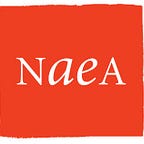Viewfinder Issue 8 — Labor of Museum Education: Letter from the Editors
Sara Egan, Keonna Hendrick, and Kabir Singh, Viewfinder Editorial Board
While there are many ways to discuss the professional efforts of art museum educators, this issue examines labor in museum education from a lens of social justice and equity. From race to gender, from age to professional title, identity often impacts not only the scope of labor that museum educators are expected to complete, but also the ways in which their work is recognized by colleagues. As many of the authors in this issue discuss, the lack of expressed value for the visible and invisible labor taken on by museum educators may perpetuate societal inequities, disrupt interpersonal trust between colleagues, and place great emotional burden on the underrecognized museum educator.
Museum educators Kai Monet and Hannah Heller address the work of museum educators to advocate for racial equity, writing from their distinct perspectives. In Shifting Center: The Labor of Liberation for Educators of Color, Monet acknowledges the emotional labor often taken on by museum educators of color when Whiteness is centered within institutions. She offers educators of color entry points to shifting labor away from centralizing White comforts and legacies toward doing the work of holding space for themselves and other people of color as a form of resistance. Like Monet, Heller problematizes the normalcy of Whiteness in art museum education in her piece Working Towards White Allyship in Museums; she calls on White educators to become allies to people of color in by taking on the labor of dismantling racism in museums.
In Inherited Bias: Thinking Critically about Female Labor and the Value of Museum Education, Arryn Davis, Pamela Maldonado, and Luanne Wilson explore the implications of gender bias on perceptions of the activities of museum education departments within museums. They articulate the relevance and impact that museum education has within and across institutions, despite stereotypes that undermine the value of the field.
Nathalie Sandstrom, a recent graduate of Smith College, reflects on the importance of investing in the work of college interns through professional development and pay equity in her article, Compensation and Compassion: Creating a More Equitable Field for Emerging Museum Educators. While unpaid internships have been common in art museums, Sandstrom argues that paid labor is essential to preparing a new generation of museum educators to lead the field, offering Smith College Museum of Art’s Student Museum Educator Program as a model.
This issue addresses some of the invisible labor while calling all museum educators into action to create more equitable working environments for ourselves and our colleagues. We hope that you will find inspiration in the featured articles and recognition for all the work you do.
— The Viewfinder Editorial Board
Sara Egan
Sara Egan is a museum educator whose work is grounded in constructivism and the use of discussions about works of art to affirm all voices. She connects Boston students and teachers with the Isabella Stewart Gardner Museum as School and Youth Programs Manager. Sara holds a BA from Vassar College and an Ed.M. from the Harvard Graduate School of Education, and is an adjunct professor of art at Simmons College.
Keonna Hendrick
Keonna Hendrick is a cultural strategist whose teaching, writing, and strategic planning promote critical thinking, expand cultural perceptions, and support self-actualization. She currently serves as School Programs Manager at the Brooklyn Museum, where she leads a department of skilled and empathetic educators in designing learning experiences that invite learners to expand their understanding of themselves and the world. Her writing has appeared in numerous publications including the Journal of Museum Education (2017), Multiculturalism in Art Museums Today (2014) and the Journal of Folklore and Education (2016). As the co-creator of multicultural critical reflective practice, a professional development model, Keonna continues to provide professional development to educators in museums and classrooms nationally, including ArtsConnection, The Museum of Modern Art, Whitney Museum of American Art, National Art Education Association, and The Solomon R. Guggenheim Museum
Kabir Singh
Kabir Singh is an educator, writer, and Los Angeles native. He has been teaching in art museums since 2008 and is dedicated to working towards greater equity in education and the arts. Kabir is the ICEF Program Coordinator at the J. Paul Getty Museum, where he coordinates a five-year partnership between the Getty and the Inner City Education Foundation (ICEF) network of charter schools in South Los Angeles. He is also a VTS Trainer for the organization Visual Thinking Strategies, where he leads professional development for educators nationwide in a constructivist pedagogy that teaches thinking through conversations about visual art. Kabir serves as the National Art Education Association (NAEA) Museum Education Division Pacific Regional Representative-Elect and has previously served on the board of Museum Educators of Southern California (MESC). He holds an EdM in Arts in Education from the Harvard Graduate School of Education and a BA in Art History from Columbia University.
